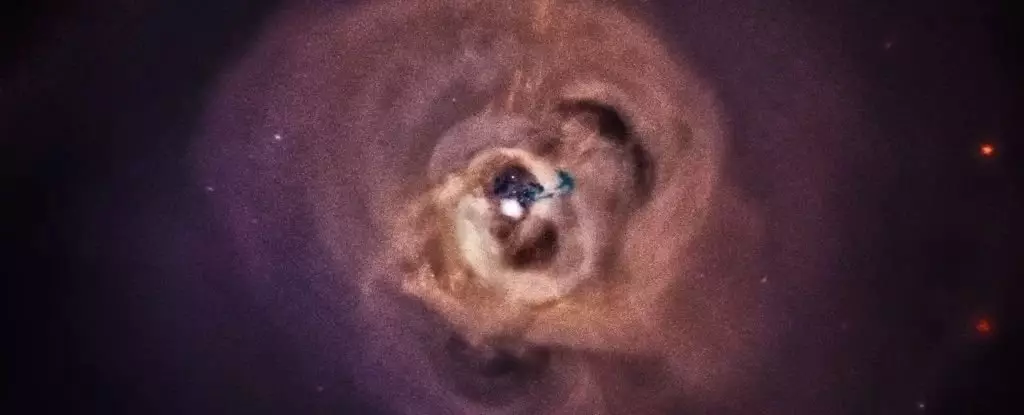The vastness of space is often depicted as a silent expanse, yet recent advancements in astronomical research illuminate a rather different narrative. The sonification of sound waves from a supermassive black hole, located 250 million light-years away in the Perseus cluster of galaxies, has opened a new frontier in our understanding of cosmic phenomena. NASA’s release of these audible waves illustrates not only the beauty of the universe but also the profound implications of sound propagation in space. This article delves into the foundational concepts behind this phenomenon, examining the intersection of sound, black holes, and the intricate dance of cosmic gases that enhances our perception of the universe.
In 2022, NASA unveiled an audio clip derived from the sound waves emitted by a supermassive black hole. When we think of black holes, we often imagine dark voids that consume all matter; however, the reality is that surrounding these enigmatic entities is a sea of gas and plasma. Acoustic waves can, in fact, travel through this medium, allowing us to capture what can be described as a cosmic orchestra. The sound waves detected were originally at frequencies too low for human ears—amplified up to 57 and 58 octaves, they transformed into an otherworldly howl that captures listeners with its eeriness and, at times, hints of aggression.
This groundbreaking achievement originated from data collected back in 2003, when astronomers first identified these striking waves emanating from the Perseus cluster. The lowest note, detectable in its original form, was determined to be a B-flat, a sound traveling at an astonishingly low pitch of 10 million years. This pitch underscores the limits of human perception, as typical human hearing is restricted to frequencies detectable in mere fractions of a second. By distilling these acoustic waves into a format we can comprehend, NASA has bridged the gap between science and sensory experience.
A common misconception is that sound cannot exist in space due to the vacuum’s absence of a medium for sound waves to propagate. Yet, within galaxy clusters, dense gases allow sound waves to reverberate, and it is this unique environment that makes the study of such phenomena possible. The intracluster medium, where sound voyages through hot, tenuous gas, serves as a medium for energy transmission, potentially affecting the dynamics of galaxy formation over long durations.
Furthermore, these sound waves not only fascinate by creating an auditory experience but also carry significant scientific value. As they propagate through intergalactic gas, they transport energy that can subsequently influence temperature regulation within the medium. Thus, the sounds we perceive offer more than just aural wonder; they serve as indicators of ongoing processes in galaxy evolution and star formation.
The task of converting cosmic data into auditory experiences hinges on advanced technology, including the prolific Chandra X-ray Observatory, which contributed substantially to the sonification project. X-ray observatories are vital in detecting high-energy processes surrounding black holes, enabling scientists to unveil the complex behaviors of these colossal entities. The sonification of the black holes provides fresh perspectives; through sound, we engage with cosmic events like never before, fostering a multidimensional understanding of the universe.
Similar efforts were employed for another supermassive black hole, M87*, famous for being the first black hole to be directly imaged. Like Perseus, M87* also underwent processes of data conversion where light from various wavelengths—including radio, optical, and X-ray—were transformed into sound. Each frequency range correlates with specific characteristics of cosmic phenomena, allowing unprecedented access to understanding the physics at play.
While the audible sounds emerging from these supermassive black holes may seem like a scientific novelty, the implications reach far beyond mere curiosity. Transformations from visual data to sound offer a unique avenue for scientific exploration, revealing details that might remain obscured in traditional observations. This multisensory approach enhances our ability to grapple with complex cosmic processes, furthering our understanding of how galaxies evolve.
Indeed, the concept of translating data into sound pushes the boundaries of contemporary research methodologies. Engaging with astronomical data through auditory means not only enriches our comprehension but also lays the groundwork for novel methods of scientific inquiry. As humanity continues to reach into the cosmos, each discovery brings us closer to bridging the gap between science and sensory experience.
The sounds originating from supermassive black holes provide a fascinating glimpse into the dynamics of the universe. As we navigate through this intricate tapestry of sound and light, we forge a deeper connection to the cosmos, unraveling its mysteries one note at a time.



Leave a Reply